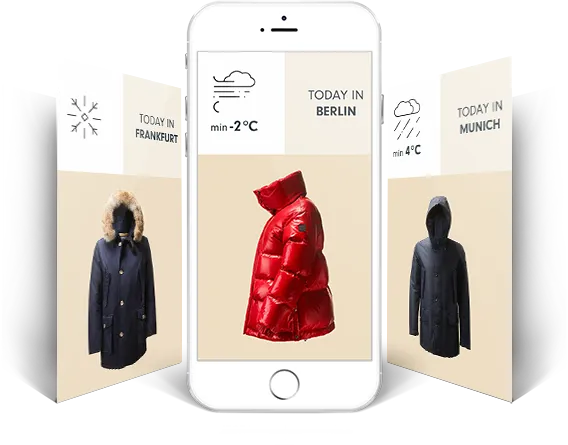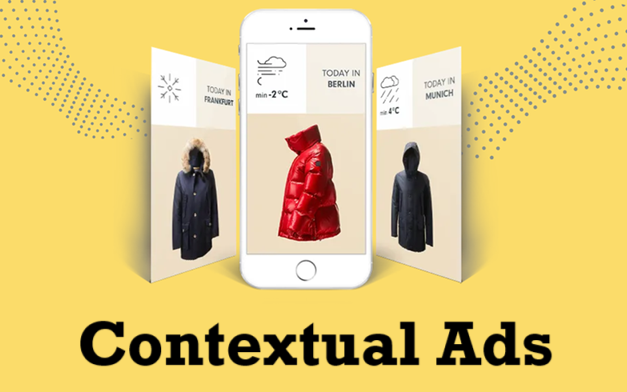Faced with thousands of advertisements being “attacked” every day, consumers’ aversion and wariness towards advertising are increasing day by day. Factors such as creativity, or emotional stories,… are not enough for advertising to create an impression and retain consumers. In that context, Contextual Ads or Contextual Advertising, with the ability to closely follow behavior and not interrupt the user experience, has become a new direction for brands. In particular, with the support of AI, Contextual Ads today not only make consumers satisfied, love advertising, but also increase conversion rates, optimize CPC, CPM costs and stimulate effective purchasing ability.
What are Contextual Ads?
Contextual targeting Ads are a type of advertising that is displayed in a way that is relevant and seamless to the content that the user is viewing. Basically, this type of Ads will help the brand’s advertising not deviate too much from the content that the user is viewing. Therefore, it does not interrupt the user experience, making them feel like the advertisement is part of the content.
For example, displaying ads about a spice right in an attractive cooking program, when the chefs are seasoning to taste their dishes. Or advertising about a cosmetic product when visitors are reading an article about makeup tips on a press page.
Today, along with the development of special context technologies, the impact of Contextual ADS is becoming more and more profound, capable of psychological stimulation and stronger customer behavior thanks to the content. increasingly sticking to the context, user experience. Therefore, expected spending on advertising will continue to increase by 13.8%/year until 2030.

Things to know Contextual Ads
Reasons why Contextual Ads are becoming more and more popular?
Contextual ADS is considered to be a type of advertising with many advantages from accurate targeting, optimizing user experience, to advantages such as optimizing advertising costs, increasing the whip rate.
A recent study from Dentsu Aegis Network and GumGum found that contextually targeted ads are significantly more effective than other types of behaviorally targeted ads. Specifically, contextual ads have up to 48% lower cost per click (CPC) and up to 36% lower cost per thousand impressions (CPM).
Also in another study by Gumgum and Spark Neuro found that Contextual Ads leads to the ability to recall ads better than 2.2 times and the level of interaction is 10% higher than the content it displays. At the same time, the intention to buy consumers also has a significant increase.

Contextual ADS is much more effective than the type of advertising targeting user behavior
How do Contextual ADS work?
The basic operating principle of Contextual ADS is to use information about Session Data to evaluate the content that customers are interested in.
1. Select keywords or themes to target context
First, the advertising system needs to know What your Campaign is? Which topic is it related to? To place ads on websites, applications have content related to that topic. Therefore, advertisers need to select the main keywords and the main topics for ads before making the context.
Topic
In particular, the theme of a campaign is usually large categories such as fashion, sports, cars, etc. Display the most accurate. For example, advertisers can choose women’s fashion, then continue to choose from some extra categories such as bags, shoes, shirts, …
Keyword
Keywords are sub -topics and terms that users can use when searching for your type of product and service such as “terrain shoes” or “travel yoga carpet”.
In addition to the main keyword, the brand should also note the negative keywords. The negative keywords are the terms that you want to exclude, which are the topics that you feel unrelated to the product, do not want your products to appear in the content of that keyword.
For example, you want to advertise for a luxury hotel and you position your brand in the high-end segment. So you want to advertise displayed on tourism content but do not want to display in the content of cheap tourism, because it is not in the same segment you target. At that time, you can analyze negative keywords such as “cheap tourism”, “cheap hotels”, …

2. Ad Network will analyze the suitable websites and applications in the network
After the advertiser places an advertising command, Ad Network will try to match your ads with the website and the most relevant content. It will conduct analysis of factors such as text, language, page structure, link structure and keywords, … to choose the website that displays advertising with high levels.
3. Ads displayed
After completing the above analysis process, AD Network will find a position that suits your advertising in terms of context.
Some of the most prominent Contextual Ads platforms in the world today are:
- Disney – Magic Words launched in 2024, using AI to match ads with content with appropriate developments and emotions. In 2025, they expanded this tool to distribute advertising on sports content and direct events.
- Warner Bros. Discovery has launched the Moments tool for Max in November, with 40 target groups available such as food, real estate, gaming and science.
- NBCuniversal has deployed 300 target groups, allowing ads to appear in terrible scenes related to family values on many different contents.
- Roku offers targeting options according to the program genre through Roku Exchange platform.
- Netflix provides advertising options according to the category of content similar to cable TV.
Exploding with the emergence of AI
Previously, the appropriate identification of context was mainly based on categories and categories on websites and applications. However, the appearance of AI has made Contextual Ads step up a new level – analyzing website content & advertising in context in each small content.
Specifically, AI will conduct detailed analysis of each content on websites, from articles to specific developments in each program, movie, … or even in real time on live programs. Since then, AI allows context advertising not only to display the right website, but also at the right time and seamlessly with the content that the user is watching.
For example, Chipotle brand has used Disney’s Magic Words tool to display advertising directly in higher education matches. Magic Words used AI to conduct analyzing the match movements in real time, grasping emotions in the match and performing advertising immediately after the most important moments, thereby helping to increase the level of identity. Brand compared to traditional advertising.
Another brand, Magna, also used this Magic Words tool of Disney. The results showed that the brand identity level increased to 6 points, the brand’s favorite level increased by 4 points and the intention to search for 2 points compared to normal advertising. This shows the outstanding effect of anyone in analyzing and searching the scenes
In addition, AI application also helps Contextual ADS to increase the conversion efficiency through identification of products in the movie scene, thereby displaying similar products for viewers on the screen. For example, the Discovery platform used AI analyzed the product in each scene and then appeared on the shoppable ADS advertising for the same function.
Overall, AI is opening a new era for Contextual ADS thanks to its ability to dissect and analyze intensive content. The context in Contextual ADS is now not only based on the theme of the site, but also depends on each detailed content such as scripts, actions, images, sounds, … to skillfully put the ads in The user’s experience series is not interrupted.
Development trend of Contextual Ads in 2025
#1. Real-time Adaptable Contextual Ads
AI technology in Contextual ADS can now analyze huge data sources to identify trends, monitor customer response and identify new potential positions and times. This allows brands to adjust strategies in real time, creating ads that are not only suitable for the topic and context of the website, but also to catch the emotions of viewers. In addition, anyone can monitor behavior and preferences of customers through context advertising, thereby helping to personalize advertising experience, improve the level of interaction and campaign effectiveness.
#2. Increased use of authentic IDs and alternative data
The removal of third -party cookies makes the advertising industry switch to authentication ID systems and alternative data such as advanced advertising advertising. This helps brands to reach customers effectively while still complying with privacy regulations. An explosive field is an advertising on connected television (CTV), where the brand needs to find new targeting solutions without depending on the cookie. The competition between advertising platforms will be increasingly fierce to develop technology to help optimize targeting in a more transparent and secure way.
In 2025, Contextual ADS will be more deeply distributed into each specific content, especially inside the videos. With AI’s support, advertising platforms can detect images, scenes and appropriate developments to display ads in each specific video. This helps the content of the ad to be integrated smoothly into each movie, program, … without breaking the experience circuit of the viewer. The trend of advertising will help videos, online TV platforms, … can exploit huge potentials from videos, movies, TV shows, ….
#3. Sustainable Content Takes the Lead in Contextual Ads
Messages and environmental protection activities are increasingly affecting consumers’ behavior. The contents of this topic are increasingly diverse from the press, movies, to music, … Therefore, using content that brings sustainable messages in Contextual ADS is opening a lot of opportunities Potential for the brand. It allows advertising to be easily received by consumers, interactions and thereby increasing their affection to the brand.
#4. The Impact of Voice Search on Contextual Ads
The development of audio search also affects small impacts on the processing process of Contextual Ads ads. For example, the user’s search keyword phrases will be longer, more ideas and naturally similar to language. At the same time they will often use more types of questions than conventional keywords. For example, instead of “buying electric cars in Hanoi”, users can say “Where can I buy cheap phones in Hanoi?”. Therefore, the brand should also study the trend of consumers’ voice searching to offer exact keywords when setting up Contextual ADS. Specifically:
- Note the long tail keywords: Users search by voice will enter the query phrase in natural speech language. For example, instead of “delivering pizza”, the query may be “I can put pizza quickly delivered near me?”. These clusters usually include a lot of long tail keywords and questions.
- Targeted by location: Most voice searches are related to the location near the user. For example: “The nearest car washing” or “recent fixed shoes”.
- Mobile device optimization: Most voice search is done on mobile devices, so make sure the factors such as advertising design, interactive feature, loading speed of the target page, … are most suitable With mobile devices.
Conclusion:
Overall, with the support of AI Contextual ADS will continue to grow stronger in the near future. In particular, the advertising features will be deeper and deeper, sticking to the behavior, emotions and user experience, helping ads become more friendly. In addition, trends such as real -time advertising, optimum Contextual ADS according to voice search, … will be bright spots that the brand needs to note in 2025.
Comment Policy: We truly value your comments and appreciate the time you take to share your thoughts and feedback with us.
Note: Comments that are identified as spam or purely promotional will be removed.
To enhance your commenting experience, consider creating a Gravatar account. By adding an avatar and using the same e-mail here, your comments will feature a unique and recognizable avatar, making it easier for other members to identify you.
Please use a valid e-mail address so you can receive notifications when your comments receive replies.
